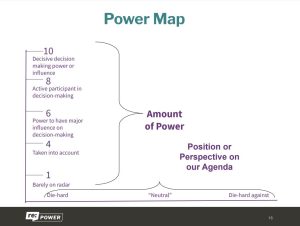22 Mapping and Analyzing Power
“Power is a tool used by a few to maintain wealth, position, and control over many, but it can also be a force shaped by the many that brings liberation and equitably-shared resources to all.”
Robert Linthicum (pg 263) Practice of Macro Social Work
Power is one of my favorite topics to discuss with students because they tend to equate ‘power’ with ‘politics,’ both feeling equally overwhelming and nebulous to them. Consequently, they tend to respond with apprehension. But, when students realize that power can be measured, identified, mapped, and manipulated, they perk up to the conversation and it quickly becomes a more interesting and fruitful discussion. It is a very dynamic part of community change work but needs to be carefully understood.
Consider that:
- POWER is the ability to influence
- POWER makes things happen
- POWER stops things from happening
- POWER is held by individuals as well as collectives
- POWER is distributed unevenly and unequally—intentionally
There are two stages of power. POWER that initiates and POWER that maintains. A goal for community organizers is to build and foster collective power with stakeholders who are willing and interested in maintaining a project or initiative. It is common for a project to be successful initially but fail after a few years because the people who control the resources were not considered or were not a part of the collective power that was intended to maintain it.
Types of Power
There are three primary types of POWER that I will be referencing: political, social, and economic. Typically, people tend to think of political power in the traditional sense of elected officials, but these other types of power are extremely important and critical to effective community organizing because they are being used all the time to change communities or maintain the status quo.
- Political Power is the ability to influence using political power, typically in an elected or appointed position (mayor, sheriff, school board, superintendent, etc.).
- Social Power is the ability to influence using social connections. People with significant social power are usually known and respected in their community or have access to social networks (faith, business, family, social media influencers, etc.).
- Economic Power is the ability to influence using financial resources. People with significant economic power may be more willing to use their financial resources for causes they support (business owners, philanthropists, elite, etc.).
Mapping Power
There are numerous steps to go through when mapping power. Since this is a dynamic process, it is best to document the map in a way that can be shifted as power is redistributed or it is shown to influence levels of support. I suggest using a large board, wall, or sheet of paper with sticky notes that can be seen but also moved. If you are doing your work virtually, use tools like Jamboard to create a virtual collaborative workspace with virtual sticky notes.
Step 1: Identify the stakeholders for the issue/project
- People who are directly impacted
- Decision makers
- Influencers
- Allies: people who care and who will consider engaging consistently
- Accomplices: people who care, share interests, and are willing to engage
- Opposition: people who have an opinion against the interest of the organizing group and are willing to engage
Step 2: Identify the power that someone has or anticipate the power
- Political power
- Social power
- Economic power
Step 3: Identify the position or opinion that someone has on an issue/project
- Level of support vs opposition
Step 4: Place them on the map according to their level of power and position[1][2]

Step 5: Analyze the map
- What does the map tell you about the level of power and extent of support?
- Of the people/groups who strongly support your issue or idea, how much power do they have?
- Of the people/groups who have a lot of power to influence, how supportive are they of your issue?
The analysis of the power map will then direct your tactics for mobilizing support for your issue or for solving your problem.